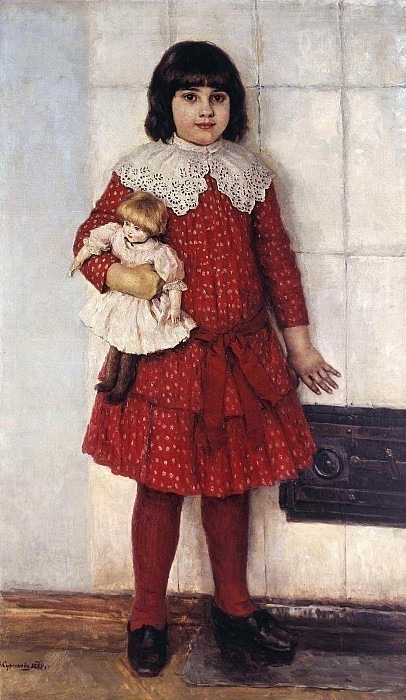Portrait of O.V. Surikova (married Konchalovskaya), the artist’s daughter, in childhood Vasily Ivanovich Surikov (1848-1916)
Vasily Ivanovich Surikov – Portrait of O.V. Surikova (married Konchalovskaya), the artist’s daughter, in childhood
Edit attribution
Download full size: 1185×2048 px (0,3 Mb)
Painter: Vasily Ivanovich Surikov
Location: The State Tretyakov Gallery, Moscow (Государственная Третьяковская галерея).
Before us is a very touching painting. The artist depicts his daughter Olga as a child. We see the pretty little girl diligently posing for her father. In her hands she holds her favorite doll. Surikov manages to convey the liveliness of his daughter’s character. She has a smile on her face. She is good-natured and very soft. In the eyes you can read the special curiosity. The face is round and very sweet.
Description of Vasily Surikov’s painting "Portrait of a Daughter
Before us is a very touching painting. The artist depicts his daughter Olga as a child. We see the pretty little girl diligently posing for her father. In her hands she holds her favorite doll. Surikov manages to convey the liveliness of his daughter’s character.
She has a smile on her face. She is good-natured and very soft. In the eyes you can read the special curiosity. The face is round and very sweet. It is framed by lush hair.
Ole is wearing a bright red dress in small polka dots of white. A large white collar made of elegant lace adorns it. Such detail makes the child’s figure more feminine.
The artist never painted portraits specifically to order. He usually posed his family. Here Surikov portrayed his eldest daughter.
We see a sturdy ten-year-old girl. You can feel her childish clumsiness. She is painted next to the stove. It is the stove that becomes a kind of background for this painting.
Olga’s gaze is strikingly open and straightforward. She looks at all the gazers. The artist succeeds in characteristically capturing the figure of his daughter. Surikov does not want to embellish his model.
This picture allows you to feel the special comfort and peace. This portrait was the logical conclusion of an entire period in the life of the painter. It was the happiest time of his life.
Impresses the special coloring of the portrait. Surikov masterfully uses color. All colors are maximally saturated. He strives for incredible expressiveness. As a result, the artist manages to write a living portrait. It seems another minute, and we’ll hear a child’s laughter, and the girl will break away.
Surikov not only portrays his daughter, but also conveys a special attitude towards her. We feel that he loves her very much.
The audience has an incredibly warm feeling. We want to believe that a great future awaits Olga. In the meantime, she conquers everyone with her spontaneity.
Кому понравилось
Пожалуйста, подождите
На эту операцию может потребоваться несколько секунд.
Информация появится в новом окне,
если открытие новых окон не запрещено в настройках вашего браузера.
You need to login
Для работы с коллекциями – пожалуйста, войдите в аккаунт (open in new window).




















COMMENTS: 1 Ответы
девочка очень добрая и милая
You cannot comment Why?
This is a full-length portrait of a young girl, identified as O.V. Surikova (later Konchalovskaya), the artists daughter, as a child. She stands centrally in the composition, facing directly towards the viewer with a serious, almost solemn expression.
Her hair is dark and cut in a neat bob, framing her round face. She has large, dark eyes that gaze directly at the observer, and her lips are softly closed. Her attire is a rich, red dress adorned with small, white polka dots. The dress features a tiered skirt with ruffles and a sash tied around her waist. A prominent, white lace collar, intricately detailed, encircles her neck.
She is holding a doll in her arms. The doll appears to be antique, with a porcelain-like face and hair, dressed in a light-colored outfit. The girls stance and the way she cradles the doll suggest a sense of maternal tenderness or a deep connection to her toy.
The background is somewhat sparse, with a white, tiled surface on the left and what appears to be the dark, metal door of a stove or furnace on the right. The floor is depicted with wooden planks. The lighting seems to come from the front, casting soft shadows and highlighting the textures of the fabric, lace, and the doll.
The subtexts of the painting can be interpreted in several ways: